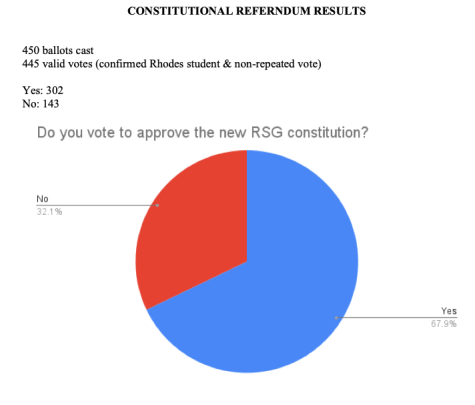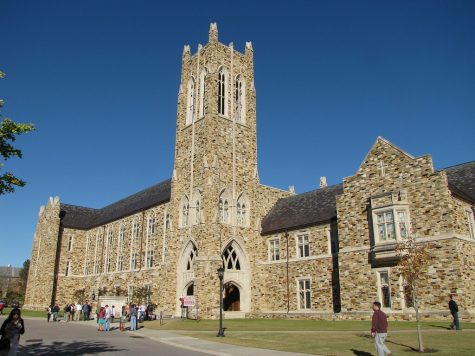Man vs. Dorm: A Tragedy in Three Parts

September 24, 2021
Violent destruction, unfair laws, and vigilante justice—all that, and more, today in this thrilling story of vandalism and punishment in the freshmen dorms.
Today we will be doing a deep dive into three different cases of vandalism in three different freshmen dorms. Much like a play, we’re going to break this down into three acts—the first and earliest incident located in Glassell, the second in Townsend, and the final in Ellet—with a monologue at the end to really drive home the overarching theme of the story: the dangers of collective punishment. So strap in and get ready for, if not the ride of your life, surely at least one the strangest rides you will experience this week.
ACT I: Glassell
The first incident was relatively simple: three ceiling tiles were destroyed on the first floor of Glassell, presumably, as one of my sources attest, on the Saturday of welcome week. My sources from the second floor describe the site as looking as if someone had bludgeoned the ceiling tiles repeatedly with some kind of blunt force object, while another source described it as looking as if someone had punched them off.
Which, honestly, is not something that would be exactly unusual in a college dorm, especially after a party on a Saturday. One can imagine hundreds of different causes: a drunken dare carried a bit too far, a mess up in coordination causing something to go swinging towards the ceiling, even drunken tomfoolery, the sense of something being hilarious at the time and the need to act on it. Truthfully, all that one would expect from a dorm filled with first year college students.
The aftermath, however, was not. On August 26th, an email went out to the whole dorm, explaining that unless the perpetrator came forth by August 30th at exactly 4:00 PM, the whole dorm would be charged a fee for the broken ceiling tiles and the mark of vandalism would go on all of their records. The residents were shocked and confused. The majority of residents had no idea about the broken ceiling tiles, even those living on the first floor, as my sources attest, were unaware of the destruction just next door. This however, soon shifted to anger.
As one of my sources from the second floor says, “I was surprised and then I was upset.”
Both of my sources emphasized the anger which seemed to radiate off members of the dorm.
“People got really angry, really fast,” says a resident of the second floor. It seemed as if the whole dorm was consumed by this feeling of frustration and anger. They felt it was “unfair”, to quote one of my sources, that they were being punished for actions outside of their control. As in most instances where people feel they are being treated unjustly and feel abandoned by the institutions meant to redress this treatment, they turned to vigilante justice. Or at least they talked about it. Both sources mentioned some form of vigilante justice in their interviews, with one saying that she and her roommate talked about “bullying them on YikYak until they stepped forward”, while another mentioned a plan where both “the second floor and third floor would stand around on the first floor until someone admitted they did it.” We do not know conclusively if any of these plans were carried out, but what we do know is at the last possible minute, a person who knew the perpetrator slipped a note under one of the RA’s doors on which the perpetrator was identified, ending the whole incident.
ACT II: Townsend
Recently, several incidents of Damage have occurred across campus. In Townsend Hall, a toilet, according to an email sent to students, was “pulled from the hinges [with] leftover waste left on the toilet”. “It’s stupid” said Jake Sanders, a freshman on the second floor “probably a drunk buffoon”. Students in Townsend can expect to be charged “If the individual(s) responsible cannot be identified, then the charge is equally distributed among the community members” according to the email sent to students.
ACT III: Ellett
It first happened just before 2 AM on the morning of September 6th, 2021. Upon Ellett Hall RA, Declan Delaney’s return from a night out with a friend, he went upstairs to his room only to find the exit sign above it was dangling several inches from the floor. It had been ripped violently out of the ceiling tile and smashed. Live wires were exposed, it was in the way of his door, and it looked like a mess. Several minutes later, another student texted the Ellett Hall GroupMe; four people had ripped the exit sign and several others on the second floor out of the ceiling. Questions quickly arose, tempers flared, and a general sense of confusion lingered over the dorm for the next week or so. It’s been nearly a month now, and no one has come forward.
When asked about the aftermath of the incident and the concept of collective punishment at Rhodes, Delaney stated, “it [seemed] rather unfair,” but he also stated that he felt it helped the dorm grow as a community. It seems, then, feelings about the collective punishment policy vary in Ellet. While some see it as an honest attempt at getting the community within each dorm to band together and take care of their space, others feel the consequences inflicted on the occupants when accidents are overly severe.
The Final Monologue: The Merits of Collective Punishment
All of these incidents have one common theme–that of collective punishment–and all of them raise a similar question: is collective punishment a fair and effective way of dealing with vandalism in dorms?
Before we get into that more, we need to go into Rhodes’ stance on collective punishment.
Rhodes College adopts a collective punishment system for any damages incurred by students living in a dorm. If the perpetrator comes forward, then they, and other accomplices, will be solely responsible for paying the damages. If not, then the cost is divided between every single resident in the dorm. This is a hassle for the RA, as they must file work orders, reports, and fill out a mountain of paperwork they would have not otherwise done, but arguably an even worse hassle for the students. If the perpetrator doesn’t own up, and they frequently don’t, then everyone in the dorm loses money and must live with the reduced living conditions caused by vandalism for some time. In this way, the “collective” part of collective punishment takes effect.
This policy alone raises some questions. First, if you break school property within your dorm, do you simply take the punishment and own up to it, thus saving your fellow students money and time, or do you let them all pay for the mistakes of one or a few? Second, what if the perpetrator comes from outside of the dorm? As RA Delaney pointed out, “the perpetrator could live somewhere else.” This adds another layer to figuring out the culprit. If they don’t live within the dorm, then they likely feel no need to come forward. Is it fair for a group of people to be punished for something one of their own may not have even done? Is it fair for people to be held accountable for things they didn’t do? Overall, all of these questions hint about the idea of accountability and fairness. The fact of the matter is that no one can and should be held accountable for actions outside of their control, and I think we can all agree that, for the most part, the incidents were all outside of the control of those in the dorms beside the perpetrator. There was nothing they could do to prevent the incidents, especially as they had no idea it was coming. Most collective punishment policies state their purpose is to force the group to police themselves and their behavior. However, one cannot police themselves when one does not know when, how, or even if an incident is going to occur. To put such a burden on a group of freshmen students is absurd.
Even beyond that, numerous studies have proven that collective punishment is only effective when a large majority of the group are accountable for the actions being punished. A study done by a group of scientists for the American Journal of Psychology, established a direct correlation between the effectiveness of collective punishment and the percentage of the group accountable for the thing they are being punished for. Collective punishment was only effective when it was a vast majority who were accountable or complicit in the action, otherwise it was proven to be ineffective, and raises the risk of others in the group doing the same. A member of the group being punished for something they had not done or known about is more likely to engage in said behavior, as, if they are to be punished for it anyway, they might as well deserve it.
Even beyond that, collective punishment often encourages factionalism in large groups, as well as toxic ways of enforcing norms. The person who caused the group to be punished may face bullying, harassment, or alienation. Even when one does not know the perpetrator, they may instead choose to punish the suspected group instead. At the very least, the group seen as responsible for the incident will face some form of alienation from the larger group. One can even see that in the cases of vandalism in the dorms. Both of my sources of Glassell asserted they no longer trusted the first floor, and one even emphasized her ongoing suspicion of the golf team for both destructions.
At the same time, they also emphasized how the incident helped the “second and third floor to bond” as a community. This sentiment is echoed by Delaney, who stated that it “helps bring together the community by holding each other accountable.” However, is it truly a community when it excludes one whole group of people? Is a community a body which is to be factionalized, where members of the community hold resentment and suspicion towards other members? Is this what Rhodes stands for? At a college that notably emphasizes the importance of community, it’s weird how they pass and uphold policies which contribute to the crumbling of that same ideal. Is this what we, as a community, stand for?Overall, Rhodes could definitely benefit from revamping their policy regarding collective punishment. Instead of many paying for the mistakes of the few, a culture in which those responsible for vandalism feel no pressure coming forward, regardless of the consequences, is needed. This helps the majority of people who don’t feel the need to commit exit sign homicide on a Monday night out quite a bit, and would likely help the culprit learn from their actions and not repeat them. Overall, it’s up to us individually to decide how we feel regarding collective punishment, but nonetheless, one has to acknowledge the dangerous effects it had on both our overall community and the dorms as a whole.













